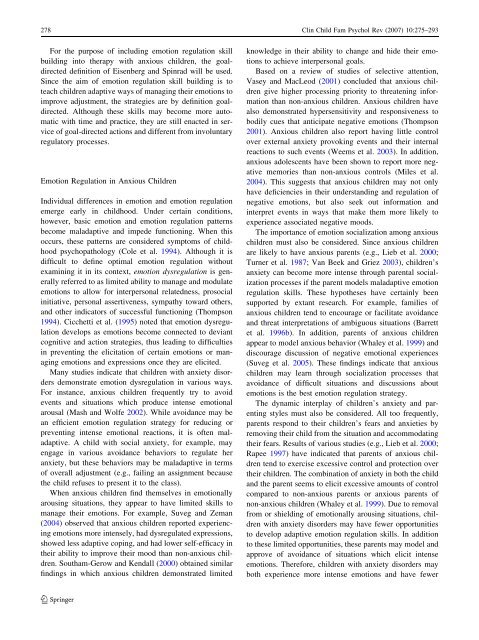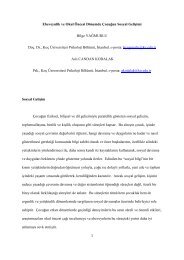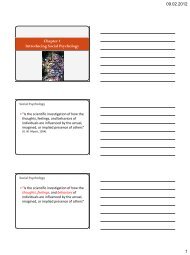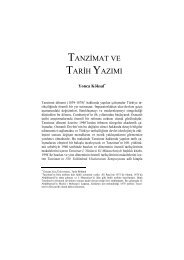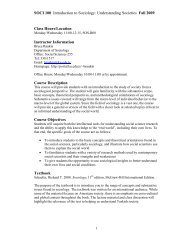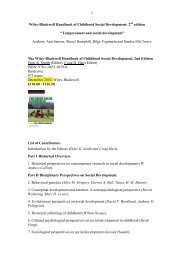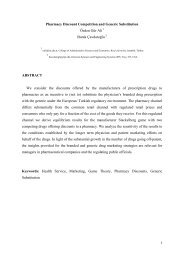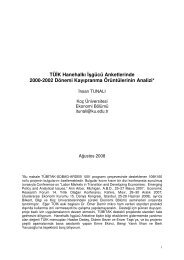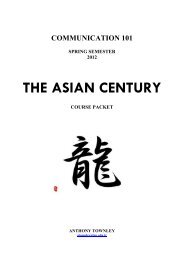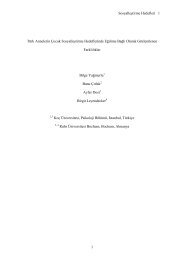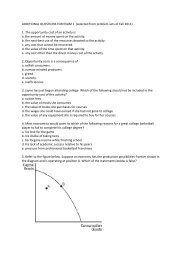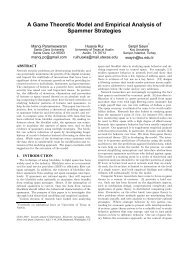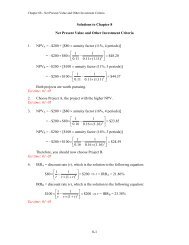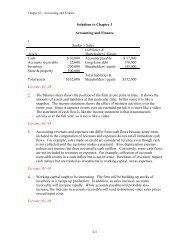The Role of Emotion Regulation in the Treatment of Child Anxiety ...
The Role of Emotion Regulation in the Treatment of Child Anxiety ...
The Role of Emotion Regulation in the Treatment of Child Anxiety ...
You also want an ePaper? Increase the reach of your titles
YUMPU automatically turns print PDFs into web optimized ePapers that Google loves.
278 Cl<strong>in</strong> <strong>Child</strong> Fam Psychol Rev (2007) 10:275–293<br />
For <strong>the</strong> purpose <strong>of</strong> <strong>in</strong>clud<strong>in</strong>g emotion regulation skill<br />
build<strong>in</strong>g <strong>in</strong>to <strong>the</strong>rapy with anxious children, <strong>the</strong> goaldirected<br />
def<strong>in</strong>ition <strong>of</strong> Eisenberg and Sp<strong>in</strong>rad will be used.<br />
S<strong>in</strong>ce <strong>the</strong> aim <strong>of</strong> emotion regulation skill build<strong>in</strong>g is to<br />
teach children adaptive ways <strong>of</strong> manag<strong>in</strong>g <strong>the</strong>ir emotions to<br />
improve adjustment, <strong>the</strong> strategies are by def<strong>in</strong>ition goaldirected.<br />
Although <strong>the</strong>se skills may become more automatic<br />
with time and practice, <strong>the</strong>y are still enacted <strong>in</strong> service<br />
<strong>of</strong> goal-directed actions and different from <strong>in</strong>voluntary<br />
regulatory processes.<br />
<strong>Emotion</strong> <strong>Regulation</strong> <strong>in</strong> Anxious <strong>Child</strong>ren<br />
Individual differences <strong>in</strong> emotion and emotion regulation<br />
emerge early <strong>in</strong> childhood. Under certa<strong>in</strong> conditions,<br />
however, basic emotion and emotion regulation patterns<br />
become maladaptive and impede function<strong>in</strong>g. When this<br />
occurs, <strong>the</strong>se patterns are considered symptoms <strong>of</strong> childhood<br />
psychopathology (Cole et al. 1994). Although it is<br />
difficult to def<strong>in</strong>e optimal emotion regulation without<br />
exam<strong>in</strong><strong>in</strong>g it <strong>in</strong> its context, emotion dysregulation is generally<br />
referred to as limited ability to manage and modulate<br />
emotions to allow for <strong>in</strong>terpersonal relatedness, prosocial<br />
<strong>in</strong>itiative, personal assertiveness, sympathy toward o<strong>the</strong>rs,<br />
and o<strong>the</strong>r <strong>in</strong>dicators <strong>of</strong> successful function<strong>in</strong>g (Thompson<br />
1994). Cicchetti et al. (1995) noted that emotion dysregulation<br />
develops as emotions become connected to deviant<br />
cognitive and action strategies, thus lead<strong>in</strong>g to difficulties<br />
<strong>in</strong> prevent<strong>in</strong>g <strong>the</strong> elicitation <strong>of</strong> certa<strong>in</strong> emotions or manag<strong>in</strong>g<br />
emotions and expressions once <strong>the</strong>y are elicited.<br />
Many studies <strong>in</strong>dicate that children with anxiety disorders<br />
demonstrate emotion dysregulation <strong>in</strong> various ways.<br />
For <strong>in</strong>stance, anxious children frequently try to avoid<br />
events and situations which produce <strong>in</strong>tense emotional<br />
arousal (Mash and Wolfe 2002). While avoidance may be<br />
an efficient emotion regulation strategy for reduc<strong>in</strong>g or<br />
prevent<strong>in</strong>g <strong>in</strong>tense emotional reactions, it is <strong>of</strong>ten maladaptive.<br />
A child with social anxiety, for example, may<br />
engage <strong>in</strong> various avoidance behaviors to regulate her<br />
anxiety, but <strong>the</strong>se behaviors may be maladaptive <strong>in</strong> terms<br />
<strong>of</strong> overall adjustment (e.g., fail<strong>in</strong>g an assignment because<br />
<strong>the</strong> child refuses to present it to <strong>the</strong> class).<br />
When anxious children f<strong>in</strong>d <strong>the</strong>mselves <strong>in</strong> emotionally<br />
arous<strong>in</strong>g situations, <strong>the</strong>y appear to have limited skills to<br />
manage <strong>the</strong>ir emotions. For example, Suveg and Zeman<br />
(2004) observed that anxious children reported experienc<strong>in</strong>g<br />
emotions more <strong>in</strong>tensely, had dysregulated expressions,<br />
showed less adaptive cop<strong>in</strong>g, and had lower self-efficacy <strong>in</strong><br />
<strong>the</strong>ir ability to improve <strong>the</strong>ir mood than non-anxious children.<br />
Southam-Gerow and Kendall (2000) obta<strong>in</strong>ed similar<br />
f<strong>in</strong>d<strong>in</strong>gs <strong>in</strong> which anxious children demonstrated limited<br />
knowledge <strong>in</strong> <strong>the</strong>ir ability to change and hide <strong>the</strong>ir emotions<br />
to achieve <strong>in</strong>terpersonal goals.<br />
Based on a review <strong>of</strong> studies <strong>of</strong> selective attention,<br />
Vasey and MacLeod (2001) concluded that anxious children<br />
give higher process<strong>in</strong>g priority to threaten<strong>in</strong>g <strong>in</strong>formation<br />
than non-anxious children. Anxious children have<br />
also demonstrated hypersensitivity and responsiveness to<br />
bodily cues that anticipate negative emotions (Thompson<br />
2001). Anxious children also report hav<strong>in</strong>g little control<br />
over external anxiety provok<strong>in</strong>g events and <strong>the</strong>ir <strong>in</strong>ternal<br />
reactions to such events (Weems et al. 2003). In addition,<br />
anxious adolescents have been shown to report more negative<br />
memories than non-anxious controls (Miles et al.<br />
2004). This suggests that anxious children may not only<br />
have deficiencies <strong>in</strong> <strong>the</strong>ir understand<strong>in</strong>g and regulation <strong>of</strong><br />
negative emotions, but also seek out <strong>in</strong>formation and<br />
<strong>in</strong>terpret events <strong>in</strong> ways that make <strong>the</strong>m more likely to<br />
experience associated negative moods.<br />
<strong>The</strong> importance <strong>of</strong> emotion socialization among anxious<br />
children must also be considered. S<strong>in</strong>ce anxious children<br />
are likely to have anxious parents (e.g., Lieb et al. 2000;<br />
Turner et al. 1987; Van Beek and Griez 2003), children’s<br />
anxiety can become more <strong>in</strong>tense through parental socialization<br />
processes if <strong>the</strong> parent models maladaptive emotion<br />
regulation skills. <strong>The</strong>se hypo<strong>the</strong>ses have certa<strong>in</strong>ly been<br />
supported by extant research. For example, families <strong>of</strong><br />
anxious children tend to encourage or facilitate avoidance<br />
and threat <strong>in</strong>terpretations <strong>of</strong> ambiguous situations (Barrett<br />
et al. 1996b). In addition, parents <strong>of</strong> anxious children<br />
appear to model anxious behavior (Whaley et al. 1999) and<br />
discourage discussion <strong>of</strong> negative emotional experiences<br />
(Suveg et al. 2005). <strong>The</strong>se f<strong>in</strong>d<strong>in</strong>gs <strong>in</strong>dicate that anxious<br />
children may learn through socialization processes that<br />
avoidance <strong>of</strong> difficult situations and discussions about<br />
emotions is <strong>the</strong> best emotion regulation strategy.<br />
<strong>The</strong> dynamic <strong>in</strong>terplay <strong>of</strong> children’s anxiety and parent<strong>in</strong>g<br />
styles must also be considered. All too frequently,<br />
parents respond to <strong>the</strong>ir children’s fears and anxieties by<br />
remov<strong>in</strong>g <strong>the</strong>ir child from <strong>the</strong> situation and accommodat<strong>in</strong>g<br />
<strong>the</strong>ir fears. Results <strong>of</strong> various studies (e.g., Lieb et al. 2000;<br />
Rapee 1997) have <strong>in</strong>dicated that parents <strong>of</strong> anxious children<br />
tend to exercise excessive control and protection over<br />
<strong>the</strong>ir children. <strong>The</strong> comb<strong>in</strong>ation <strong>of</strong> anxiety <strong>in</strong> both <strong>the</strong> child<br />
and <strong>the</strong> parent seems to elicit excessive amounts <strong>of</strong> control<br />
compared to non-anxious parents or anxious parents <strong>of</strong><br />
non-anxious children (Whaley et al. 1999). Due to removal<br />
from or shield<strong>in</strong>g <strong>of</strong> emotionally arous<strong>in</strong>g situations, children<br />
with anxiety disorders may have fewer opportunities<br />
to develop adaptive emotion regulation skills. In addition<br />
to <strong>the</strong>se limited opportunities, <strong>the</strong>se parents may model and<br />
approve <strong>of</strong> avoidance <strong>of</strong> situations which elicit <strong>in</strong>tense<br />
emotions. <strong>The</strong>refore, children with anxiety disorders may<br />
both experience more <strong>in</strong>tense emotions and have fewer<br />
123


